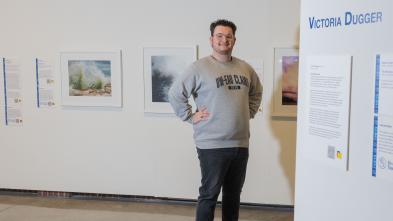The initial partnership between UW-Stout and UW-Eau Claire stemmed from a recognition that while nursing and packaging engineering share common interests, there's a lack of opportunities for undergraduate students from these disciplines to learn about each other's fields before graduation. The DRIVE Initiative was developed to address this issue, equipping students with essential skills for their respective fields while fostering interdisciplinary collaboration.
Through research, hands-on experience and direct input from healthcare professionals, the project seeks to improve patient safety, environmental sustainability and economic efficiency.
Dr. Charlotte Sortedahl, a professor in the UW-Eau Claire College of Nursing, is collaborating with Dr. Min DeGruson, UW-Stout packaging program director, on this initiative.
A key differentiator of the DRIVE Initiative is its focus on gathering direct input from practicing nurses regarding how nursing students can better learn about and utilize sterilized medical packaging and devices. This feedback directly informs the development of educational materials and packaging kits.
The collaboration between nursing and packaging engineering students provides a unique opportunity to address real-world challenges in healthcare. Nursing students, who eventually will work with sterilized medical devices in clinical settings, gain a deeper understanding of the packaging process, while packaging students develop insight into the needs and constraints of medical environments.
This interdisciplinary approach ensures that future healthcare workers and engineers enter the workforce with a more comprehensive perspective on patient safety and medical device usability. One specific skill students are expected to gain is enhanced preparedness for their first jobs, particularly in acute-care settings, related to the proper use of sterilized medical packaging and devices.
"Nurses and packaging engineers don’t typically interact during their education, yet both play critical roles in patient safety. By working together early on, students can develop a shared understanding that benefits both fields," Sortedahl explains. This collaboration is crucial, as it allows students to see the challenges and perspectives of both disciplines firsthand.
One of the key objectives of the DRIVE Initiative is to incorporate feedback from practicing nurses to refine educational materials and packaging kits for use in the curricula. Surveys conducted with registered nurses working in acute care settings provide valuable insights. This direct input helps shape the development of sterilized medical packaging kits and instructional resources, which are then integrated into nursing curricula. The educational materials and packaging kits will provide students with more information and hands-on practice using sterilized medical packaging and its contents, potentially increasing their knowledge and confidence in these essential procedures. "One of the challenges in acute care settings is dealing with packaging that isn’t always intuitive," Sortedahl says.
Additionally, the project emphasizes sustainability and cost-effectiveness. By exploring materials and designs that reduce waste while maintaining sterility and ease of use, the initiative aligns with broader healthcare industry goals of minimizing environmental impact. The DRIVE Initiative will integrate sustainable practices in several ways, including incorporating information about recyclable components in educational resources. This aims to facilitate less waste, improve recycling practices and promote economic efficiency in healthcare settings.
"Sustainability in medical packaging isn’t just about reducing waste; it’s also about making smarter choices that balance sterility, usability and environmental impact," Sortedahl says. "The DRIVE Initiative is exploring how to integrate these considerations into student learning."
The DRIVE Initiative also fosters long-term collaboration between healthcare professionals and engineers beyond the academic setting. By equipping students with interdisciplinary problem-solving skills, the project lays the groundwork for continued innovation in medical packaging and patient safety. The initiative aims to foster long-term collaboration by starting at a smaller scale, allowing students to experience interdisciplinary teamwork before entering the workforce. If successful, this model can be expanded to create stronger connections between packaging engineers and healthcare professionals. This long-term vision is essential for ensuring continued progress in the field.
Feedback from healthcare professionals will be gathered through various means, including surveys of registered nurses working in acute-care settings. This direct input will be crucial in ensuring that the packaging kits and educational materials are practical and useful and connected to real-world healthcare settings. The key goal for the DRIVE Initiative in the next year is to gather feedback from registered nurses about their perspectives on improving nursing students' preparation for the workforce, particularly regarding the use of sterilized medical packaging.
As the initiative progresses, there is potential for expansion into other healthcare-related disciplines, further strengthening the connection between engineering and healthcare education. Recognizing that nursing is a collaborative profession, the DRIVE Initiative anticipates exploring opportunities to involve additional disciplines in the future to improve medical packaging and patient safety. Connecting to nurses in the field will assist in bridging practice and academia.
Written by Kaylan Petrie, administrative coordinator, UW-Eau Claire College of Nursing



